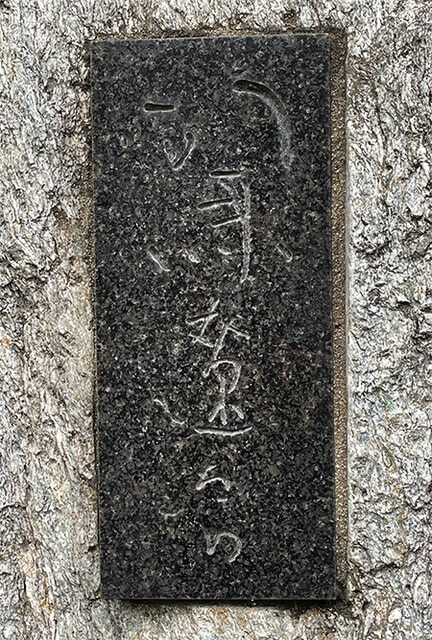
きのうのブログテーマ「霊柩車遭遇」ですが、わたし自身は「いい方」解釈派だったのですが、昨夕関西から帰還したのですが、なぜか搭乗機が「機体トラブル」で後発便よりも新千歳空港到着が遅れて、約2時間の遅延の事態に。こういうトラブル経験はしばらくなかったので、どうもあの霊柩車遭遇との関連を疑わざるを得ませんでした(笑)。
まぁしかし、そういうトラブルでも遅れたとは言え、安全を確保してなんとか運航してくれたので、災い転じて安寧も得られたと考えられるので、やはり「禍福はあざなえる縄のごとし」でしょうか。
写真は、播州姫路の縁の英賀神社境内のとある箇所に鎮座している、石碑。読みにくいと思いますが、司馬遼太郎さんがその自筆筆跡を残したものです。とくの「司」の字の崩しぶり、また「太郎」の簡略ぶりにはファンとしては完全にノックアウトされる思いがしてくる(笑)。いかにもかれの家系の故地での探訪時に求められて気軽に書いた自署という雰囲気が感じられる。こういった部分に、作家の「肉声」が、言霊のように宿っているように思えてならず、こちらに行く度に参観させてもらっている。

機縁自体は、かれ司馬遼太郎さんが書いた「播磨灘物語」。歴史の掘り起こし型、独自のジャーナリズムとも思える歴史作品を書き続けたかれの、もっともその「肉声」に近い作品だった。かれの家系はこの英賀城跡地に建ち続けている神社と深く関わっている。その地縁と、わたし自身の家系の伝承とが、クロスしている。
司馬遼太郎さん自身は、血縁などというものは一種の迷信に近い、というようなコトバを残しているけれど、しかし残された「縁のある」人間としては、それも含めて感受せざるを得ない。
その土地の雰囲気、その地で暮らした人びとの思いとか息づかいなどを、空気感として感受する機会として全国の神社を巡ることは多いけれど、この英賀神社とこの石碑には特別の思いがしている。
わたしは北海道人だけれど、もっと以前はこういった空気感のなかで生き続けてきた人びとの「末裔」であるということも伝わってきて、そこでの時間の痕跡が、なつかしさとなって反応してくるようになる。そうなんです、何回行っても、そのたびに別の想念、あたらしい気付きがそこここに発見させられる。また、そこでの時間経過も気付かされることも多い。
人間の形而上世界というものには、科学で捉えきれないなにごとかはあるのだろうと思っていますが、そういう「味わい」にだんだん「ハマって」来ているのかも知れません(笑)。
English version⬇
Himeji Eiga in “A Connection” with Mr. Ryotaro Shiba
There must be such a thing as dialogue with the dead. Stones may be the final “dwelling place” of the human soul. I am healed by its interest. The stone is a place where the soul of a person is healed.
I myself was of the “good” interpretation of the theme of yesterday's blog, “Hearse Encounter,” but when I returned from Kansai last evening, for some reason, the plane I was boarding had an “aircraft trouble” and arrived at New Chitose Airport later than the later flight, resulting in a delay of about two hours. I had not experienced this kind of trouble for a while, so I had to suspect that it was related to the hearse encounter (laugh).
Well, however, even though the flight was delayed due to such a trouble, it managed to operate safely, so I guess we were able to turn our misfortune to our advantage and enjoy peace of mind.
The photo is a stone monument that sits in a certain spot in the precincts of Eiga Shrine, which is located on the edge of Banshu-Himeji. It may be difficult to read, but it is the handwriting of Ryotaro Shiba. As a fan of Ryotaro Shiba, I was completely knocked out by the character “Tsukasa” in “Toku” and the simplicity of “Taro” (laugh). It gives the impression that this was a casual autograph written at the request of the writer during a visit to the place where his family had passed away. I feel as if the writer's “voice” resides in these parts of the book, like the spirit of his words, and I visit the book every time I come here.
The occasion itself was “Harimanada Monogatari” written by Ryotaro Shiba, the author of “Harimanada Monogatari” (The Tale of Harimanada). It was the work that was closest to the “voice” of Ryotaro Shiba, who continued to write historical works that could be considered as journalism in its own right, in the style of historical excavation. His family is deeply connected with the shrine that continues to stand on the site of Eiga Castle. This connection and my own family traditions are crossed.
Ryotaro Shiba himself said that blood relations are a kind of superstition, but as a person with a “connection” to a place, I cannot help but be aware of this as well.
I often visit shrines throughout Japan as an opportunity to get a sense of the atmosphere of the land and the thoughts and feelings of the people who lived there, but this Eiga Shrine and this stone monument have a special place in my heart.
Although I am from Hokkaido, I can feel that I am a “descendant” of people who lived in this atmosphere long ago, and the traces of the time I spent there make me nostalgic and responsive. Yes, no matter how many times you visit, each time you will discover new thoughts and new insights here and there. I am also often reminded of the passage of time there.
I believe that there is something in the human metaphysical world that cannot be captured by science, and perhaps I am gradually becoming “addicted” to this kind of “taste” (laughs).




























※コメント投稿者のブログIDはブログ作成者のみに通知されます